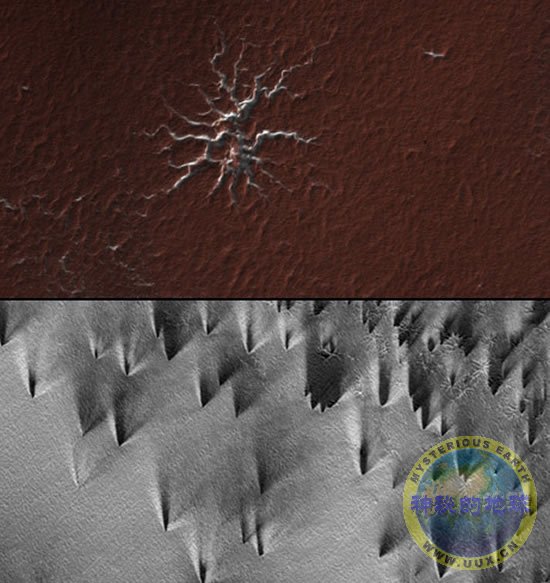Riddle of Mars's Mysterious "Spiders," "Fans" Solved
New images from NASA's orbiting HiRise camera have revealed some of the secrets behind Mars's bizarre "spiders" (top) and "dark fans" (bottom).
The spiders are delicate tunnels under the polar ice generated by melting carbon dioxide gas, while the fans are alternating deposits of carbon dioxide "snow" (white) and dust (black) thrown out by the erupting gas, experts say.
Images courtesy NASA/JPL/University of Arizona
Richard A. Lovett in San Francisco, California
for National Geographic News
December 12, 2007
New images from Mars have revealed startling details about "spiders" and "dark fans"—two of the bizarre features that the give the planet's so-called cryptic region its name.
The formations appear during the spring in a region near the planet's south pole dense with unusual features.
Fan-shaped layers of dust, for example, accumulate on top of the region's polar ice, spreading in the direction of the prevailing winds.
Scientists have long suspected that spring sunshine warms the carbon dioxide ice, causing it to transform directly into gas and spew dust out like a dirty geyser. (See what a Martian ice "geyser" might look like.)
Now new high-resolution images taken from NASA's orbiting HiRise camera are revealing the delicate internal structure of these gas jets.
The pictures also provide insights into wind patterns and daily cycles on the red planet, scientists say.
Spiders
"Like the Earth, Mars experiences seasons. Unlike the Earth, the polar cap is made out of carbon dioxide, or dry ice," Candice Hansen, of NASA's Jet Propulsion Laboratory, said yesterday at a meeting of the American Geophysical Union in San Francisco, California.
"The carbon dioxide ice is translucent," she added. "That allows sunlight to penetrate and warm the surface below."
The warm dirt transfers heat to the bottom layer of ice, which turns to gas. As pressure builds, the gas scours channels beneath the ice, picking up dust.
When the moving gas finds a hole or breaks through a weak spot, the dust spews into the air and then rains back to the surface downwind.
The new HiRise images clearly show the network of pipelike channels feeding each jet.
Some are simply lacelike patterns, but others have legs extending in all directions.
"You can see the sort of spiderlike shape," Hansen said. "They drape over the local topography. In fact, they love to sit on top of little hummocks."
Unlike rivers, which flow downhill, many of Mars's formations do the reverse.
"The channels widen and deepen as they go uphill," Hansen said. "That type of erosion is consistent with gas as the erosion agent."
The channels can get up to six feet (two meters) deep, the images show.
Shifting Winds
Using an infrared detector called the Compact Reconnaissance Imaging Spectrometer for Mars, HiRise was also able to determine the composition of bright streaks that often angle outward from the dust deposits, like slightly wider fans.
These streaks are comprised of carbon dioxide rather than dust, said Tim Titus of the U.S. Geological Survey in Flagstaff, Arizona.
The fact that the white streaks and the black fans don't perfectly align indicates that they were produced at different times of the day, Titus added.
At dawn, there isn't enough heat from the sun to melt any gas, he pointed out. Later gas flows form, but they're not fast enough to pick up any dust.
When this gas escapes into the air, it expands and cools rapidly, raining back carbon dioxide "snow" to the surface.
"Our calculation is that as much as 2 percent of the gas can get converted back into frost," Titus said. "That's plenty to form these [white] fans."
When the heat picks up strength later in the day, the stronger gas jets begin picking up dust. But by then the wind has shifted, sending the darker dust in a different direction as the frost.
In the afternoon the process slows down again, producing a new bright streak representing still another slight shift in wind direction.
Global climate models for Mars predict the normal wind speeds at various times of day.
Thus, Titus said, "the direction of the fans can tell us a lot about what time of day they were formed."












